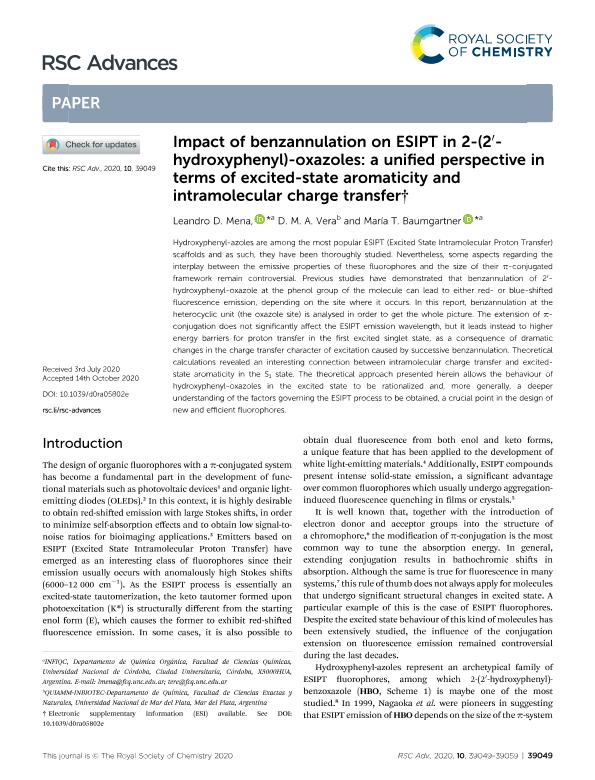Mostrar el registro sencillo del ítem
dc.contributor.author
Mena, Leandro Daniel

dc.contributor.author
Vera, Domingo Mariano Adolfo

dc.contributor.author
Baumgartner, Maria Teresa del V.

dc.date.available
2021-03-18T17:48:11Z
dc.date.issued
2020-10
dc.identifier.citation
Mena, Leandro Daniel; Vera, Domingo Mariano Adolfo; Baumgartner, Maria Teresa del V.; Impact of benzannulation on ESIPT in 2-(2′-hydroxyphenyl)-oxazoles: A unified perspective in terms of excited-state aromaticity and intramolecular charge transfer; Royal Society of Chemistry; RSC Advances; 10; 64; 10-2020; 39049-39059
dc.identifier.uri
http://hdl.handle.net/11336/128564
dc.description.abstract
Hydroxyphenyl-azoles are among the most popular ESIPT (Excited State Intramolecular Proton Transfer) scaffolds and as such, they have been thoroughly studied. Nevertheless, some aspects regarding the interplay between the emissive properties of these fluorophores and the size of their π-conjugated framework remain controversial. Previous studies have demonstrated that benzannulation of 2′-hydroxyphenyl-oxazole at the phenol group of the molecule can lead to either red- or blue-shifted fluorescence emission, depending on the site where it occurs. In this report, benzannulation at the heterocyclic unit (the oxazole site) is analysed in order to get the whole picture. The extension of π-conjugation does not significantly affect the ESIPT emission wavelength, but it leads instead to higher energy barriers for proton transfer in the first excited singlet state, as a consequence of dramatic changes in the charge transfer character of excitation caused by successive benzannulation. Theoretical calculations revealed an interesting connection between intramolecular charge transfer and excited-state aromaticity in the S1 state. The theoretical approach presented herein allows the behaviour of hydroxyphenyl-oxazoles in the excited state to be rationalized and, more generally, a deeper understanding of the factors governing the ESIPT process to be obtained, a crucial point in the design of new and efficient fluorophores.
dc.format
application/pdf
dc.language.iso
eng
dc.publisher
Royal Society of Chemistry

dc.rights
info:eu-repo/semantics/openAccess
dc.rights.uri
https://creativecommons.org/licenses/by/2.5/ar/
dc.subject
ESIPT
dc.subject
PROTON TRANSFER
dc.subject
CHARGE TRANSFER
dc.subject
AROMATICITY
dc.subject.classification
Química Orgánica

dc.subject.classification
Ciencias Químicas

dc.subject.classification
CIENCIAS NATURALES Y EXACTAS

dc.title
Impact of benzannulation on ESIPT in 2-(2′-hydroxyphenyl)-oxazoles: A unified perspective in terms of excited-state aromaticity and intramolecular charge transfer
dc.type
info:eu-repo/semantics/article
dc.type
info:ar-repo/semantics/artículo
dc.type
info:eu-repo/semantics/publishedVersion
dc.date.updated
2020-12-04T18:36:48Z
dc.identifier.eissn
2046-2069
dc.journal.volume
10
dc.journal.number
64
dc.journal.pagination
39049-39059
dc.journal.pais
Reino Unido

dc.journal.ciudad
Londres
dc.description.fil
Fil: Mena, Leandro Daniel. Universidad Nacional de Río Cuarto. Facultad de Ciencias Exactas Fisicoquímicas y Naturales. Instituto de Investigaciones en Tecnologías Energéticas y Materiales Avanzados. - Consejo Nacional de Investigaciones Científicas y Técnicas. Centro Científico Tecnológico Conicet - Córdoba. Instituto de Investigaciones en Tecnologías Energéticas y Materiales Avanzados; Argentina
dc.description.fil
Fil: Vera, Domingo Mariano Adolfo. Consejo Nacional de Investigaciones Cientificas y Tecnicas. Centro Cientifico Tecnologico Conicet - Mar del Plata. Instituto de Investigaciones En Biodiversidad y Biotecnologia. Grupo de Investigacion En Quimica Analitica y Modelado Molecular.; Argentina
dc.description.fil
Fil: Baumgartner, Maria Teresa del V.. Consejo Nacional de Investigaciones Científicas y Técnicas. Centro Científico Tecnológico Conicet - Córdoba. Instituto de Investigaciones en Físico-química de Córdoba. Universidad Nacional de Córdoba. Facultad de Ciencias Químicas. Instituto de Investigaciones en Físico-química de Córdoba; Argentina
dc.journal.title
RSC Advances
dc.relation.alternativeid
info:eu-repo/semantics/altIdentifier/url/https://pubs.rsc.org/en/content/articlelanding/2020/RA/D0RA05802E
dc.relation.alternativeid
info:eu-repo/semantics/altIdentifier/doi/https://doi.org/10.1039/D0RA05802E
Archivos asociados
